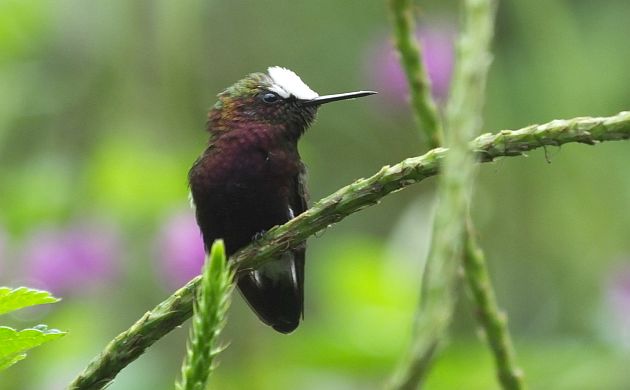
Snowcaps are simply surreal. Not the sublime chocolate ones crowned with sugar but the live feathered ones that look like they have been dipped in choice burgundy and topped with a luminescent satin cap.
The adult males sport that look; a bird created with crayons and an imaginative mind. Even better, when they zip between flower patches, the glowing white crown stands out like a miniature fairy light, one that bounces between among small tropical flowers.
The female isn’t quite so unreal but is still a cool little bird in her own right. Plumaged like various other small female hummingbirds from North America, the lady Snowcap is pale gray below, pale glittering green above, and with a tail that flashes bits of white. She also makes a mark with her small size, one of the smallest birds in Costa Rica.
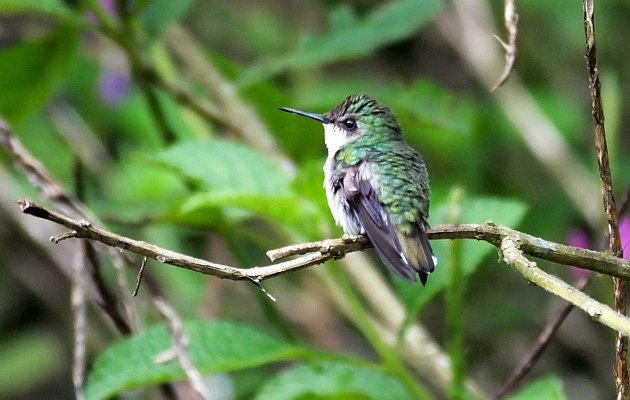
When you see a photo of a Snowcap, it’s easy to see why this species is a perennial top target for birding trips to Costa Rica. See one in person and anyone can understand why the Snowcap makes it onto the top 10 list, even top 3 birds of most birding trips to Costa Rica. However, as with so many other bird species that must be seen to confirm their improbable existence, the Snowcap can be elusive. It’s not all that rare, there just tend to be difficulties seeing tiny birds that live in the canopy of tall, dense rainforest. Think straining for looks at kinglets or Firecrests 40 meters (120 feet) above the ground in light-challenged, densely vegetated situations.
If you do happen to see one way up there in the canopy, since it’s more like watching a dark bug flying around than admiring the shifting colors of a dark velvet chocolate hummingbird, the Snowcap experience deserves to be enjoyed at ground level.
Fortunately, as long as the right flowers are present, this special hummingbird isn’t adverse to foraging at eye level. It will visit certain wild flowers but since many tend to be seasonal, the most reliable places to view Snowcaps are gardens planted with Verbena. Also known as Porterweed or Jamaican Vervain, this flowering bush is one of the top, natural hummingbird feeders of all time and Snowcaps love it. Visit classic birding sites such as Rancho Naturalista or El Copal and you have a fair chance of seeing one or more of those little beauties. However, if you have time for some birding much closer to San Jose, this choice hummingbird is also regular at one of the newest Costa Rica birding spots on the block; the intriguing Nectar and Pollen reserve. Check out these very good reasons to visit:
Easy Access
Located on the main highway between San Jose and Limon, Nectar and Pollen is easy to visit by car or even public bus. It’s around an hour from San Jose, an hour and 30 minutes from Alajuela (like near the airport). If you happen to be birding the La Selva area, the drive is around 45 minutes. The site is just down the road from the Rainforest Aerial Tram.
A Garden Planted for Birds
Some years ago, Miguel, an experienced naturalist guide, began to plant fruiting trees and Porterweed bushes on part of his uncle’s farm. Already situated next to foothill rainforest in the buffer zone of Braulio Carrillo National Park, it wasn’t long before birds (and a lot of butterflies!) started to visit those plantings, an area on the property now known as Nectar and Pollen. A recent, brief visit left me impressed with the number of birds that came to the vegetation in the garden, birds like Purple-crowned Fairy, Crowned Woodnymphs, Cinnamon Woodpecker, and even a rare Blue-and-gold Tanager. Snowcaps were there too, we had four or five, and most at close range.
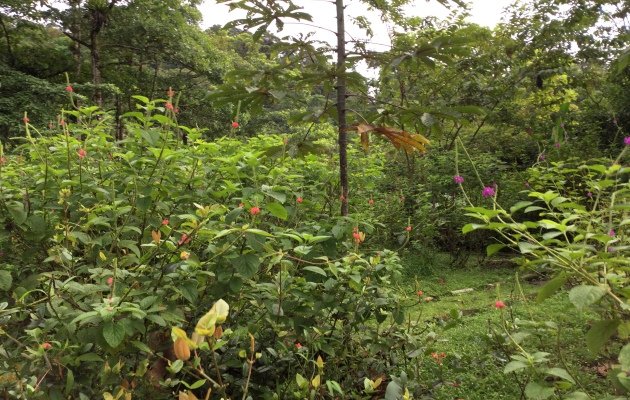
Foothill Rainforest!
Much to a birder’s joy, Nectar and Pollen is adjacent to an excellent area of mature foothill rainforest. That acts as a fine source for birds visiting the gardens as well as other species that stick to the forest. Even better, since this forest is connected to the extensive rainforests of Braulio Carrillo National Park, at some time or another, the habitat at Nectar and Pollen probably hosts everything from the endangered and spectacular Bare-necked Umbrellabird to shy antbirds and handsome Tawny-crested Tanagers.
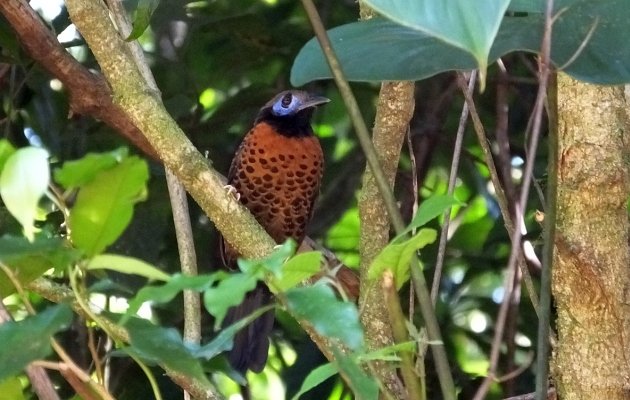
Trails are available and although I have yet to explore them, I bet they harbor a number of “good” species. I look forward to doing surveys there!
Raptors, Tanagers, and More
Thanks to being situated next to good areas of rainforest, Nectar and Pollen looks to be a great spot for watching raptors. Views are good from the gardens but much better from an area of pasture that offers 360 degree views of forested hills and sky. From that point, on a sunny morning, we watched a Double-toothed Kite and a White hawk rise into the air and soar among the more common Black and Turkey Vultures. King Vulture is regular and various other species are also possible, hawk-eagles included.
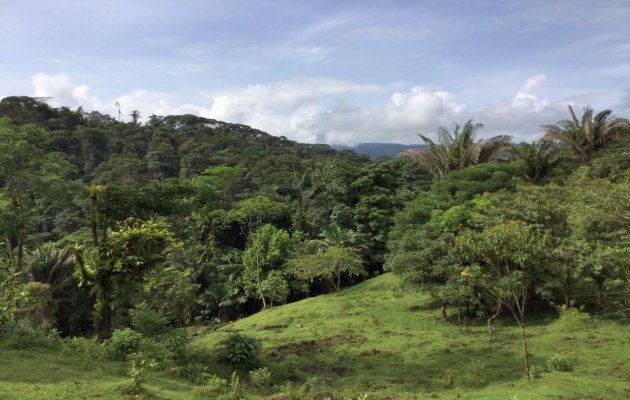
The tanager situation is also good nd includes various species visiting fruiting trees. In addition to that Blue-and-Gold, we also had Emerald, Speckled, Silver-throated, Bay-headed, and Scarlet-rumped Tanagers as well as Black-faced Grosbeaks, Black-cheeked Woodpecker, and other birds. I’m sure several other species also occur.
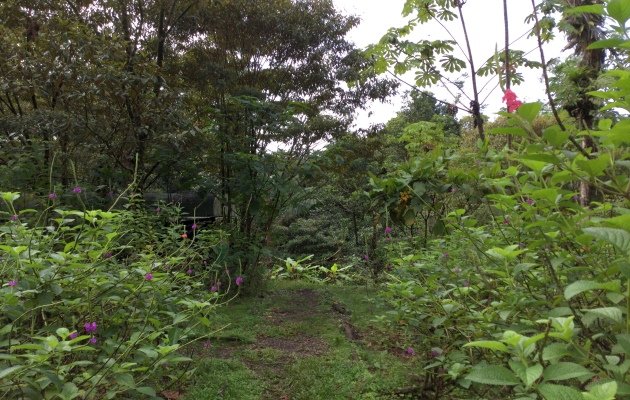
Since Nectar and Pollen is located on a small farm, reservations are required for Miguel to open the place and show you around. The entrance fee may depend on if you visit as a group or on your own and may cost around $20. Contacting Miguel is easy and done via the Facebook page for the site. He speaks English well and as a fellow birder, will be happy to hear from you. In the meantime, study those tanagers, flying raptors, and look forward to seeing a Snowcap or two!













Thank you, Patrick. I’m so glad to hear of locals developing gardens for the birds and their oglers! I hope to visit Miguel someday. It must be hard to keep the eco-tourism going during this endless pandemic so I wish you all the best in CR.
@Karen- Yes, it’s really cool to see people doing that. I hope you visit some day. As with so many other places, the pandemic has had a big effect on tourism and it has been a challenge for many local businesses.